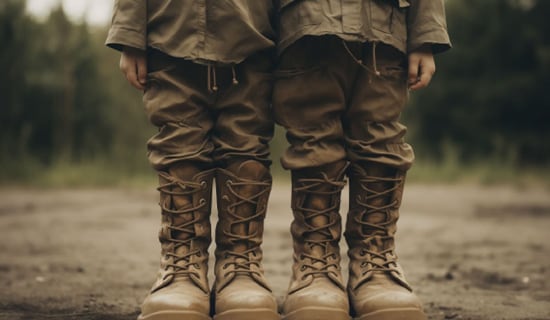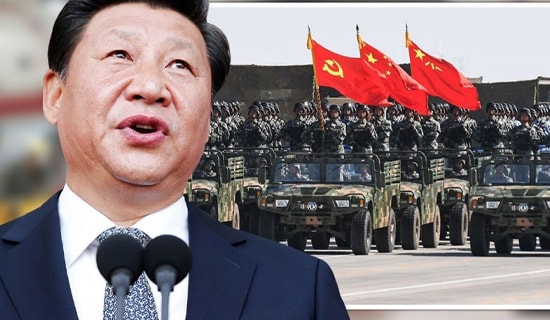March 30, 2017, marked the 150th anniversary of the Treaty of Cession between Russia and the U.S, under which Russia sold its Alaskan Territory to the U.S.. In an article, titled 'Selling Alaska for next to nothing is a disgrace,' the Russian media outlet Gazeta.ru explained Russia's motivations to conclude the deal and the consequences of the concession. It is worth noting that on April 17, 2014, during the annual Direct Line call in program, Russian President, Vladimir Putin ridiculed the idea of annexing Alaska. Responding to the question "Are there any plans regarding the annexation of Alaska? We would be very happy to see that happen. Thank you. Pensioner Faina Ivanovna," Putin said: "Faina Ivanovna, why do you need Alaska? By the way, Alaska was sold sometime in the 19th century. Louisiana was sold to the United States by the French at about the same time. Thousands of square kilometers were sold for $7.2 million, although in gold. We can calculate the equivalent amount, but it was definitely inexpensive. Russia is a northern country with 70% of its territory located in the north and the far north. Alaska is not located in the southern hemisphere, either, is it? It’s cold out there as well. Let's not get worked up about it, all right?" During the Direct Line, the TV host Kirill Kleymenov also mentioned that in Russia Alaska is jokingly called "Ice-Crimea."[1] It is actually not coincidental that in the Crimean town of Yevpatoria, there is a monuments that reads: "We have returned Crimea, you are to return Alaska."
Meanwhile, Russian military planes recently approached Alaska four days in a row. The media outlet Alaskan Dispatch News reported: "Two Alaskan-based F-22 Raptors and two Royal Canadian Air Force CF-18 Hornet fighters intercepted the two Russian TU-95 turboprop bombers about 7 p.m. Thursday [April 20, 2017]… Col. Harlie Bodine said Russian aircraft flew in international airspace in all four instances this week. He said military officials 'have seen no indication of these aircraft being armed'… Russia last sent bombers to the coast near Alaska in 2015. Bodine said Alaska military officials were unaware of the reasoning behind Russia's four consecutive flights near the state's coast this week."[2]
On April 19, the Russian Defense Ministry confirmed that on the same day two Russian Tu-95MS bombers were escorted by US F-22 fighters near Alaska. The Russian Defense Ministry said: "Over the international waters near Alaska Tu-95MS jets were escorted by F-22 fighters of the US Air Force during 27 minutes… All flights of the Aerospace Force were carried out and are carried out in strict accordance with the international rules of using the air space over the neutral waters without violating the borders of other states."[3]
On March 29, Russian President Vladimir Putin and Prime Minister Dmitry Medvedev visited the Arctic.[4] During the visit, Putin stated that the U.S., Russia's neighbor in the Arctic, develops its military activity, which Moscow considers a "threat" at Russia. Putin said at the Arctic Forum: "While what we are doing is of local nature, what the U.S. is doing in Alaska is of global nature. A missile defense system is being developed there. This system is one of the most serious problems of the modern times in the security sphere. It's not just a defense system, it's a part of the nuclear potential brought to the periphery."[5] Recently, the Russian Ministry of Defense's website posted an interactive excursion around Russia's "Arctic Trefoil" military base, located on Alexandra Land Island in the Franz Josef Archipelago in the Arctic region. According to the Russian Ministry of Defense, the base can provide up to 150 servicemen with living accommodations for 1.5 years.[6]
Below are excerpts of the article, published in Gazeta.ru:[7]
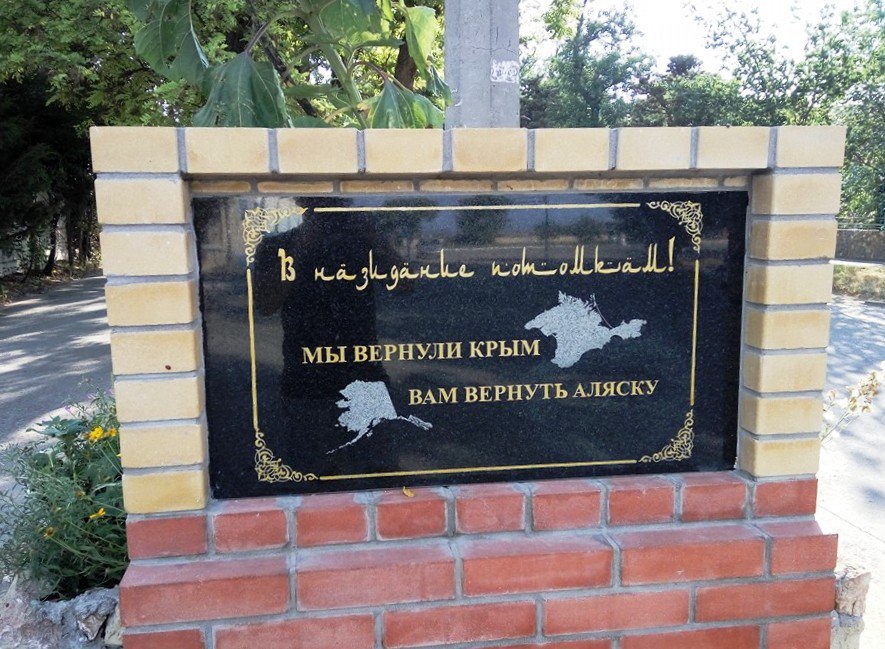
Monument in the Crimean town of Yevpatoria reads: "We have returned Crimea, you [too] will return Alaska."
(Source: twitter.com/nv_krym)
'During The 125 Years That Alaska Was Owned By The Russian Empire, It Remained Practically Undeveloped'

Russian rock band Lyube's video of the 1992 hit song 'Do Not Fool with Us, America!' The words of the song say: "The czars were wrong! Russia and Alaska are two banks of the same river! Give back our dear land, dear Alaska, give it back to us!" See video: ЛЮБЭ "Не валяй дурака, Америка"
"The Europeans knew nothing about Alaska until the 18th century, when its shores were sighted by the members of [Russian explorer] Semyon Dezhnev’s expedition. And the first Europeans to ashore on what is now the American state were the crew of St. Gabriel – a ship that arrived there in 1732 as part of the expedition led by Afanasy Shestakov and Dmitry Pavlutsky.
"With time, Russian settlements appeared in Alaska, and missionaries actively converted the local pagans to the Russian-Orthodox faith. The economy of Russian America, which included some other territories (the Aleutian Islands, the Alexander Archipelago, etc.) in addition to Alaska, was founded on the sea-mammals hunting industry. Alaska was colonized by the Russian-American Company (RAC), a semipublic trade company, which was mostly interested in fur trade. At first, it competed with Lebedev-Lastochkin’s company, but later Lebedev’s people left Alaska, and RAC remained as a monopolist.
"The first person to speak about selling Alaska to the U.S. was Nikolai Muravyov-Amursky, governor general of Eastern Siberia, as early as 1853, under the reign of [Tsar] Nicholas I. In his evaluation: 'With the invention and development of railways, we need to fully realize, with even greater clarity than before, that the United States of America will inevitably spread over the entire North American continent, and we must be aware of the fact that sooner or later we will have to yield our North American possessions to them,'
"Russia maintained hostile relations with Britain. During the [1854] Crimean War, Britain, striving for [naval] supremacy in the Pacific, sent a fleet with a marine corps on board to the port city of Petropavlovsk (now Petropavlovsk-Kamchatsky). The defense of Petropavlovsk became one of the most significant battles of the Crimean War. Despite the enemy’s nearly threefold advantage in numbers, Russian troops managed to defend the city. But the threat of confrontation in the territory of Russian America became evident. The U.S. government, not eager to see Alaska occupied by the British Empire, proposed a deal to Russia on a three-year temporary transfer of Alaska and other Russian American territories to U.S. control. But the transfer never happened – Russia managed to reach an agreement with the British Hudson’s Bay Company.
"Next time, the issue of selling Alaska was raised by the Emperor’s younger brother, Duke Konstantin, in his correspondence with the Foreign Minister, Alexander Gorchakov, who endorsed the idea.
"During the 125 years that Alaska was owned by the Russian Empire, it remained practically undeveloped – only on the coast and in a few spots along the Yukon River were there infrequent settlements and hunting bases. Alaska’s Indians, in contrast to the Aleut, refused to cooperate and did not accept the Russians. Skirmishes between the Russians and the Indians often ended in tragedy. The colony experienced serious difficulties – the number of Russians living there during the entire period of its existence did not exceed 600–800 persons, and the economic situation deteriorated rapidly. The economic basis of the colony was fur trade, but now there were problems with it: kalan (sea beaver), whose fur was very valuable, had been nearly exterminated, while the fur of fur seals was not in high demand. Minks, beavers and foxes were hunted by the Indians inland.
SUPPORT OUR WORK

"In order to survive somehow, the colony traded in fish, coal, and even Alaskan ice.
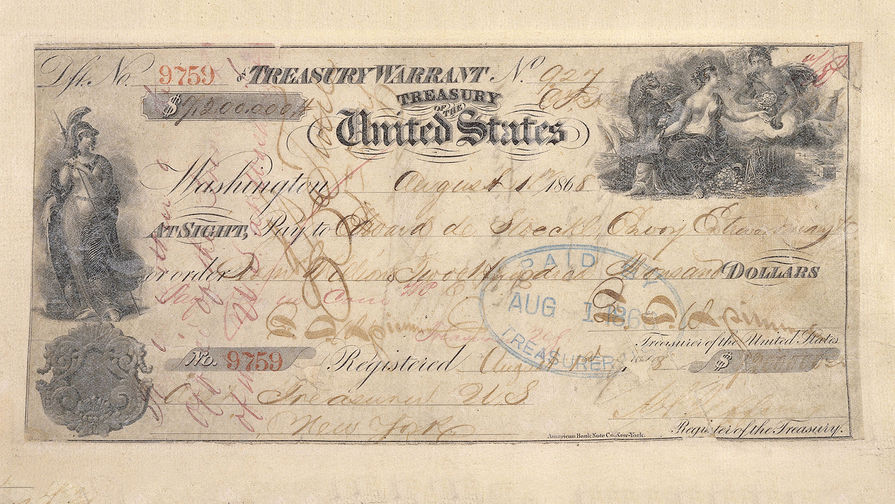
A check for $ 7.2 million submitted for the purchase of Alaska (Source: Gazeta.ru)
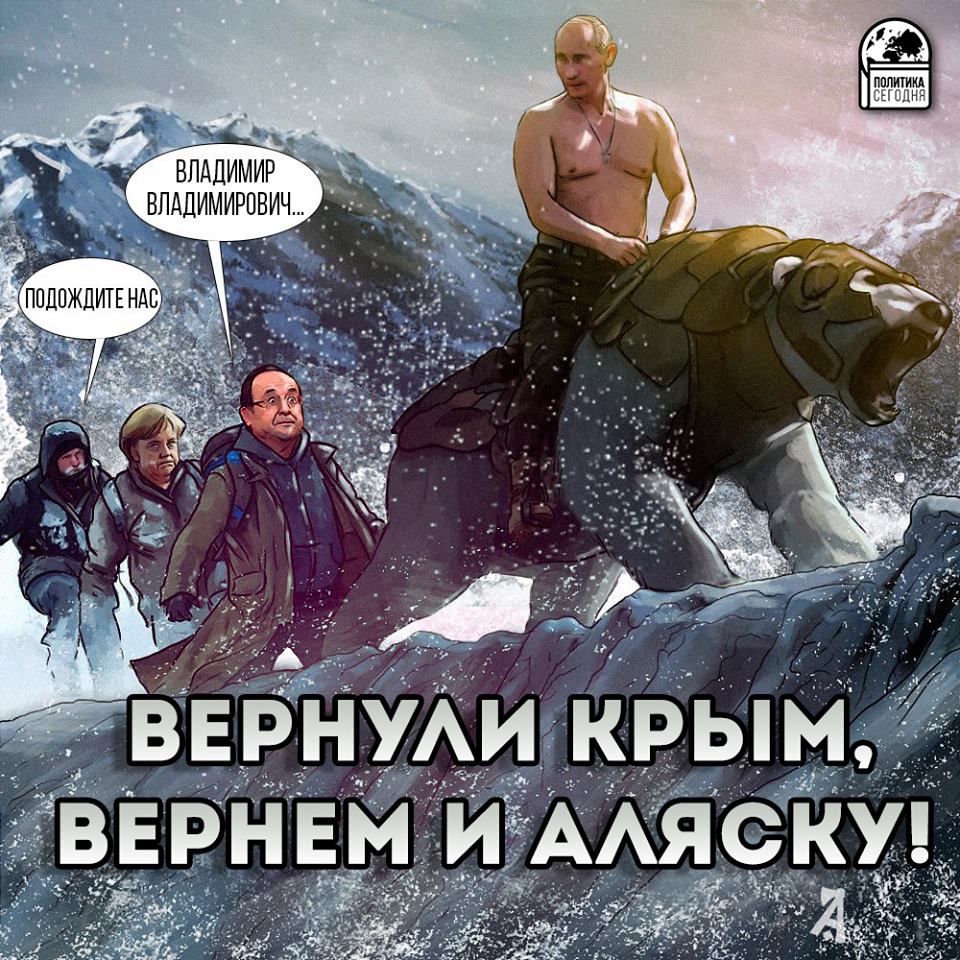
Caption: "We have returned to Crimea, we will return to Alaska."
French President Francois Hollande: "Vladmir Vladimirovich…"
Man behind German chancellor Angela Merkel: "Wait for us"
(Source: Facebook.com/politicst0day, March 29, 2017)
'The Sale Of Alaska Was The First Instance When The Russian Empire Voluntarily Relinquished Its Possessions'

Siberian Pop singer Mashany singing: "We should have returned Alaska a long time ago!” See video of the 2016 song "Ruble-Dollar": Машани - Рубль - доллар
"Russian America needed constant financial support from St. Petersburg, but after the Crimean War Russia was in need of money itself. Moreover, Alaska was vulnerable – it could be occupied by Britain or the U.S., poachers appeared time and again in coastal waters, and the strained relations with the Indians threatened Russian lives. All this lead Russia to the idea of selling Alaska before it was simply lost.
"Deliberations on the sale lasted until late 1866. In December, a conference took place, attended by the Emperor and his brother, heads of the Finance and the Naval Ministries, and the Russian envoy to Washington, Baron Eduard von Stoeckl. As a result of the meeting, its participants approved the idea of sale.
"Stoeckl informed the U.S. Secretary of State William Seward of Russia’s readiness to discuss the sale of Alaska. The payment should have been at least five million dollars in gold. These terms suited the American government, and on March 30, 1867, the agreement to sell Alaska to the U.S. for $7.2 million was signed in Washington.
"The U.S. got Alaska and the adjacent isles; the overall area of the transferred territory was about 1,519,000 sq. km. 'The major reasons for selling Alaska were articulated by the Grand Duke Konstantin. He was the mastermind and the implementer of this sale,' Doctor of Historical Sciences Aleksandr Petrov comments to Gazeta.ru. 'The first was that the Russian-American Company was losing money. But, in fact, it was not so; it was bringing significant profit to the Treasury. The second reason was that Russia should pay more attention to the development of the Amur River region and, as they said then, 'rounding off' the borders of the Russian Empire. The third was that it was necessary to develop and establish more friendly relations with the United States.'
"Many were outraged by this development. A Petersburg newspaper Golos ['Voice'] wrote in April 1868: 'Selling Alaska for next to nothing is a disgrace and a betrayal of our pioneers' memory. We cannot treat this incredible rumor as anything other than a nasty joke exploiting the credulity of the society… Can it be that the fruits of labor of Shelikhov, Baranov, Khlebnikov and other selfless Russian patriots will now be enjoyed by foreigners?'
"Although the Senate voiced doubts about the advisability of this purchase, on October 10, 1868, at 15.30 Alaska was officially handed over to the U.S. After the disclosure of the agreement and the 42-gun salute, the Russian flag was lowered and the American stars and stripes flag was raised. 'The transfer of Alaska will always have a positive connotation in Russian-American relations,' says Petrov. 'The establishment of Russian-American relations started with Alaska. It was necessary to formalize the ties that already existed between the Russian-American Company and the so-called Bostonians – merchants from the young U.S. Alaska became the birthplace of Russian-American relations.'
"The sale of Alaska was the first instance when the Russian Empire voluntarily relinquished its possessions. Together with land, the Americans received all the immovable assets, colonial archives, official and historical documents.
"The population of Alaska is now over 700 thousand. Extraction of oil and other natural resources, hunting, fishing, forest harvesting, and tourism all play an important part in its economy. 'Now we can say for sure that Alaska is the kind of place where Russia is loved and understood,' says Petrov, 'where the local residents have kept elements of Russian culture; there are regions where the Russian Orthodox Church develops and the Russian language is preserved even though 150 years have passed!'"
Appendix I - Russian Possessions In America[8]

(Source: Gazeta.ru)
"So far in the 21st century, Russia has only managed to expand its territory by that of Crimea and the island of Yaya. However, it is worth recalling other territories it used to possess. Especially since… on February 28th 1825, the convention dividing North American territories between Russia and Great Britain entered into force. That convention, though, did not take into account the opinion of the United States that ended up taking over these territories. However, at the beginning of the first quarter of the 19th century the situation looked different. 'His Majesty the Emperor of All Russia and His Majesty the King of the United Kingdom of Great Britain and Ireland' simply decided to delineate their spheres of influence.
"The very first article whereby the two monarchs agreed to freedom of navigation and fishing in the Pacific Ocean makes that abundantly clear. Furthermore, the decision was made that it ships are allowed to drop anchor at places that are not yet occupied. The trade issues on the part of Russia were handled by the Russian-American company in which America took no part despite its name. An important part of the convention was the agreement that British ships are not allowed to drop anchor at the Russian territories without first securing the permission of local authorities, and vice versa. The border ran all the way along the Russian-owned coastline, from 54° north to 60° north, 10 miles from the edge of the ocean… Many territories were in fact lost much earlier.
"The Elizabethan fortress located in Hawaii had ceased to be Russian in the summer of 1817. And the rest of the overseas possessions only belonged to Russia for a short period of time. For instance, Alaska, despite common misconception, was sold to the United States by Alexander II in 1867. A special Russian-American monopoly was created to facilitate the sale. Russia was initially reluctant to sell Fort Ross, its largest settlement in California. However, Britain built a number of towns nearby and continued its expansion. This resulted in the Russian colony becoming an enclave that experienced problems with water supplies. And so the fort was sold in 1841.
"The other territories that had once belonged to Russia met a similar fate. Russian authorities chose not to cling to them since the upkeep of these colonies became highly unprofitable. The fact that the settlements were originally assigned to the Siberian Governor-General, and later transferred to the East Siberian Governor-General aggravated the situation. Simply put, they were governed form Irkutsk, located at a fair distance from California or Alaska. The Russian-American company had existed up until 1881. Founded by Paul I, for almost a century it had helped promote the interests of Russian merchants in the American territories. Along with the loss of territories discovered by [Russian explorers] Semyon Dezhnev, Vitus Bering and their followers, the company ceased to exist as well."
[1] Kremlin.ru, April 17, 2014.
[2] Adn.com, April 21, 2017.
[3] Sputniknews.com, April 19, 2017.
[4] See MEMRI Special Dispatch No.6872, Putin And Medvedev's Trip To The Arctic – Political Analyst Goltz: The PM Was Invited To Hear... 'A Strictly Confidential Message That It's Time To Be Going', April 12, 2017.
[5] Sputniknews.com, March 30, 2017.
[6] Sputniknews.com, April 18, 2017. See Video on YouTube: https://www.youtube.com/watch?v=C58AdoDqk6A
[7] Gazeta.ru, March 30, 2017. The article was authored by Alla Salkova and Pavel Kotlyar.
[8] Gazeta.ru, February 28, 2015. The article was authored by Vladimir Gelayev


